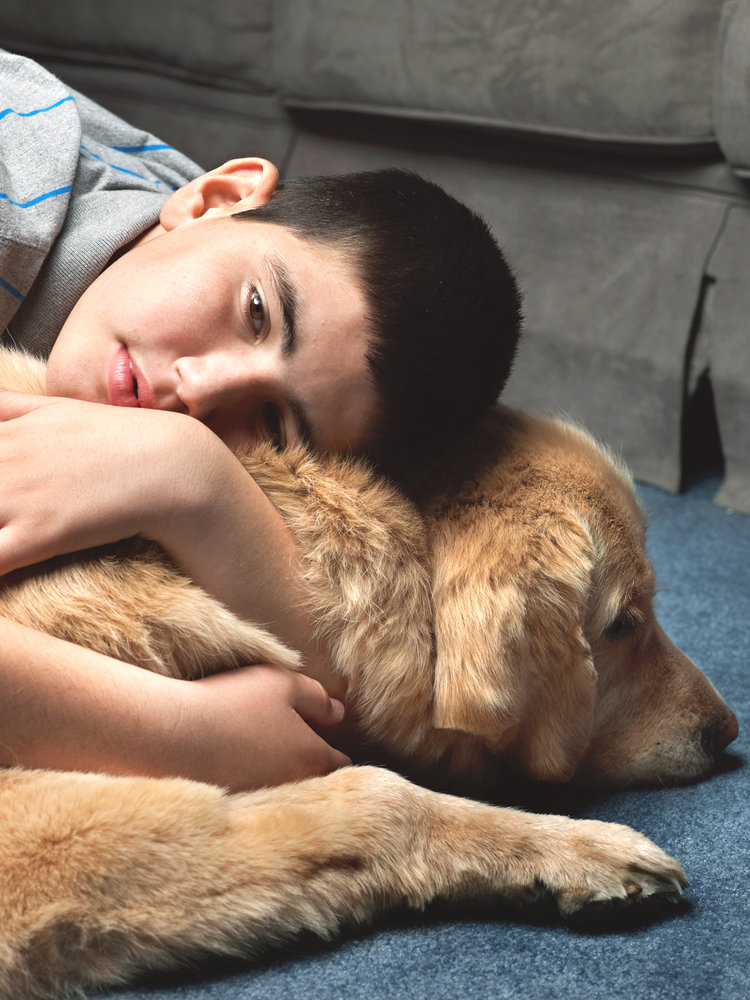
Although the girl developed typically, it soon became clear that the boy, Iyal, suffered from Fetal Alcohol Syndrome. The first part of the article is dedicated to defining Fetal Alcohol Syndrome and the challenges it presents to both the child and the parents.
Then we meet Karen Shirk, a woman who became severely disabled with Myasthenia Gravis. At the urging of a nurse, Karen began applying to agencies for a service dog. She was told she was “too disabled” to handle a dog, and no one would work with her, so she went out and adopted a dog named Ben, then hired a trainer herself. She went from being bedridden and on a ventilator to walking around with a tracheal tube that allows her to speak and breathe more easily.
Following heart surgery, Shirk noticed that Ben was especially attentive. “I had a daytime nurse but was alone at night,” she says. “I was on a morphine pump and — though I didn’t realize it — a deadly combination of drugs. I slipped into unconsciousness.” When the phone rang, Ben waited — as he’d been trained to do — for Shirk’s command to answer it rather than to let it ring into the answering machine. But that night, with his owner failing, Ben picked up the receiver without her command, dropped it on the bed and barked and barked. It was Shirk’s father. Realizing something was wrong, her father hung up and called 911. The rescue team told Shirk she wouldn’t have lived through the night.
Her experience taught her that there’s no such thing as “too disabled.” Wanting to share her experience, she began working at a day care center for disabled adults. Soon, she had the idea that she could begin training dogs to help other people who couldn’t get the other agencies to work with them. She thought she’d place four or five dogs a year. (She now places over 100 a year.)
One of her first requests for help came from the family of a 12-year old child who had been paralyzed by a spinal stroke. In October, 1998 she founded the non-profit 4 Paws for Ability in Xenia, Ohio (near Dayton) and placed her first dog with the paralyzed child.
In 2007, Iyal’s mother called Shirk to inquire about getting a dog to help her son who struggled with the after-effects of being exposed to alcohol in-utero. Shirk had never heard of the disease, but was already supplying dogs to children who have so-called “invisible disabilities” (as my children have). These children are particularly hard to handle because most of the general public doesn’t understand that the kids have a disability – they assume the kids are spoiled or have “bad” parents who can’t control them. Here’s the conversation between Iyal’s parents:
“You’re talking about a dog with a vest like a seeing-eye dog? It will be embarrassing to go into public like that!”
“It’s already embarrassing to go into public with Iyal, especially for Morasha [his sister].”
“But a dog in a vest will make him seem so disabled.”
“A dog in a vest will tell people that he acts like this because he’s living with a disability.”
Long story, short, Iyal was matched with a Golden Retriever named Chancer who had been given up by his family when they found him too hard to take care of. 4 Paws for Ability re-habbed him and got him ready to do behavioral interventions before matching him to Iyal. It appears to be a match made in heaven. As Iyal’s mother says: “Lately, and this is the best yet: if Iyal gets distressed, he goes to find Chancer, and he curls up next to him. He picks up Chancer’s big paw and gets under it.” For a child whose disability often doesn’t allow him to identify his moods, let alone do something to mitigate them, this is huge!
So, thank-you, Frank for pointing out this story to me. It was touching, heartwarming, and very informative.
Readers: if you’ve got an extra 15 – 20 minutes, go read the story in the NY Times. You’ll be glad you did.
Learn more about 4 Paws for Ability with this short video.
Until next time,
Good day, and good dog!
